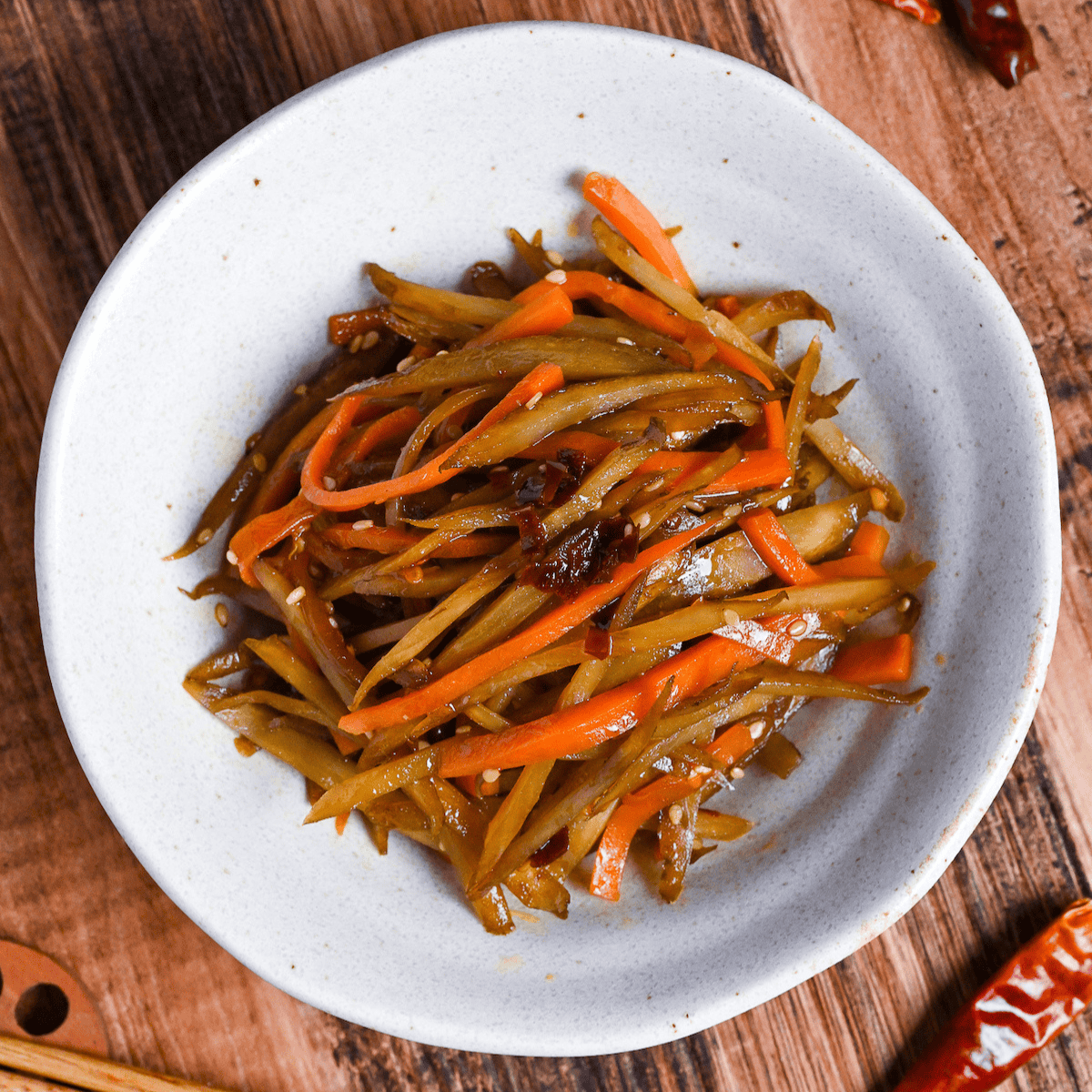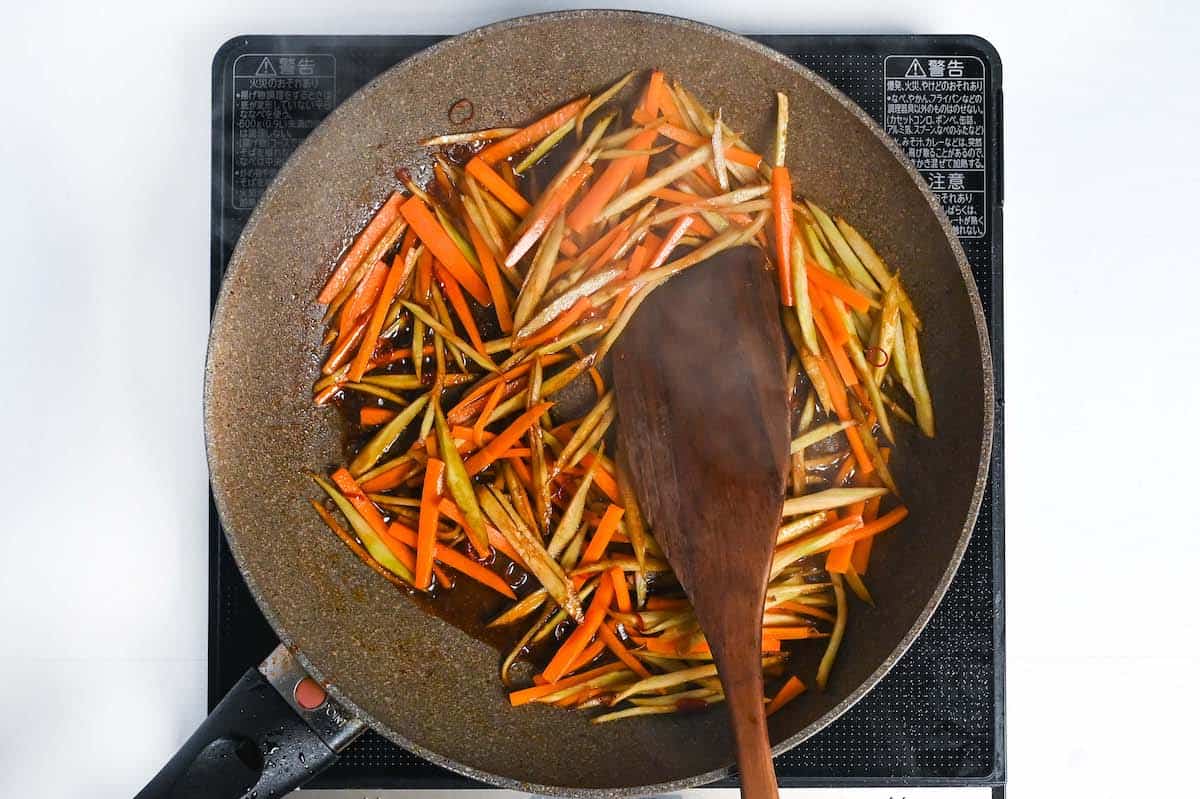Featured Comment
This recipe is what I’ve been seeking for years. It is exactly the same flavor I tasted in Okinawa restaurants 40 years ago. It is so good! Every bite I take has sweet memories. From the bottom of my heart I thank you for sharing this recipe.
★★★★★
– Denise
Ever wondered if burdock root is really edible?
In Japan, gobo stars in soups like tonjiru, simmered dishes like beef shigureni and chikuzen-ni, even hot pots like motsunabe. But its boldest moment? A golden-sweet stir-fry called kinpira gobo, and it’s easier than it looks.

Kinpira Gobo
Recipe Snapshot
- What is it? A sweet-savory stir-fry of burdock and carrot with sesame aroma and irresistible crunch.
- Flavor profile: Savory, Nutty, Slightly sweet
- Why you’ll love this recipe: It transforms that intimidating Asian grocer ingredient into a foolproof 20-minute side.
- Must-haves: Burdock root (alternatives available), Toasted sesame oil, soy sauce
- Skill Level: Easy
- Freezer Friendly? Yes!
- Suitable for Meal Prep? Yes!
Summarize & Save this content on:

What is Kinpira Gobo?
Kinpira Gobo (きんぴらごぼう) is a classic Japanese side dish made by stir-frying and lightly simmering finely sliced burdock root and carrot in a sweet-savory soy glaze. The “kinpira” method (quickly sautéing, then seasoning) creates tender-crisp vegetables with a hint of heat and a satisfying bite.
It’s one of Japan’s staple jōbisai (make-ahead sides), along with hijiki salad, simmered kabocha squash, and gomoku mame. These dishes were originally designed for easy keeping, and kinpira gobo still holds up beautifully for several days in the fridge, making it perfect for weeknight meal prep.
It’s crunchy, deeply flavored, and endlessly flexible.
Kinpira Gobo Ingredients

- Gobo (burdock root): A crisp, earthy root that stays pleasantly snappy when sautéed. You’ll find fresh gobo at large Asian groceries. Look for straight, light-brown roots without soft spots. I will explain the alternatives in the next section.
- Dashi granules & Chicken bouillon powder: These are your quickest “umami switch”. Use vegetarian alternatives for plant-based.
Burdock Root Alternatives
For those in Western countries where fresh burdock root isn’t readily available, here are several alternatives that can create a similar kinpira experience:
| Alternative | Texture & Flavor | Cooking Tips |
|---|---|---|
| Parsnip | • Surprisingly similar to burdock when stir-fried • Sweet, slightly nutty flavor • Crispy texture when julienned | • Cut slightly thicker than burdock • Cooks faster – reduce cooking time |
| Lotus Root (Renkon) | • Crunchy, slightly starchy • Mild, sweet flavor • Crisp bite even after cooking | • Slice thinner due to harder texture • Maintains crunch well |
| Salsify Root (Oyster Plant) | • Looks remarkably like burdock • Similar crunchy texture | • Handle like burdock • Peel immediately before use |
| Jerusalem Artichoke (Sunchoke) | • Crisp, water chestnut-like • Nutty, slightly sweet • Knobby ginger-like appearance | • Cooks quickly – watch timing • Cut into thick matchsticks |
Differences to Note:
- Flavor Profile: These alternatives generally lack burdock’s distinctive earthy, slightly bitter taste. The final result will be milder and sweeter. Consider adding a touch more chili to compensate for the missing complexity.
- Cooking Time: Most alternatives cook faster than burdock. Parsnips and Jerusalem artichokes especially need less time in the pan. Start checking the texture earlier to avoid overcooking.
- Texture Considerations: While burdock maintains its firm, fibrous texture throughout cooking, alternatives like parsnips can become too soft if overcooked. Cut them slightly thicker and cook over higher heat for shorter periods.
These substitutes work well not just in kinpira, but also in other Japanese dishes like takikomi gohan and chicken miso soup, where burdock is traditionally used.
How to Make My Kinpira Gobo
If you prefer to watch the process in action, check out my YouTube video of this kinpira gobo recipe!
Wash the gobo with clean running water to remove the soil. If you prefer, you can peel the skin using the back of a knife or a metal scrubber, but make sure to keep this to a minimum.
The peel holds a bundle of methoxypyrazines, compounds behind burdock’s signature “forest after rain” scent. Strip too much and you lose half the magic before you even start cooking.
Run your knife with the grain to cut thin matchsticks about 5 cm (2 inches) long and 3 to 4 mm (about ⅛ inch) wide. I recommend cutting diagonally with a focus on thinness and length, then cutting into matchstick-shaped pieces.


Keeping the fibres long means each strand holds its water better during cooking, so the final bite is satisfyingly crisp instead of floppy.
Drop the burdock into cold water, give it a little swish, and then leave it there until you’re done cutting the carrot.

That quick bath gets just the right amount of chlorogenic acid to soften any roughness without rinsing away all the antioxidants. It also prevents discoloration.
Matchstick your carrot so it can keep up with the burdock’s cook time, then thinly slice a dried red chilli, seeds out if you prefer a gentler heat.

In a small bowl stir together sake, soy sauce, chicken bouillon, and a dash of dashi granules. Use plant-based bouillon/kombu dashi granules to make it suitable for vegetarians and vegans.

Heat a non-stick pan over medium-high. Swirl in neutral oil and add the chilli. When it starts to sizzle and you catch a whiff of fruity spice, you’re ready for the vegetables.

Toasted sesame oil is a great addition to this dish, but its fragrant compounds start to dissipate at around 180 °C / 356 °F.
Using a neutral base lets you sear hot without wasting all that sesame goodness. We’ll drizzle the toasted oil at the end where it counts.
Drain the burdock root thoroughly.

Toss in the burdock and carrot, sprinkle in a bit of salt, and stir fry for about 3 minutes (if you’re using a burdock alternative, reduce the cooking time). Keep the vegetables moving; we want high heat throughout, not hot spots.

When the pieces sound squeaky against the pan and the color brightens, you’re at roughly 80% cooked, perfect for seasoning.
Pour in your umami mixture. The liquid will hiss, that’s your cue to boost the heat and drive off moisture until the pan looks almost dry.

Now add brown sugar and mirin, give everything a glossy coat.

Adding sugar before soy lets it coat the vegetable surface, building flavor without turning the whole pan bitter.
And, last of all, splash in the soy sauce. Count to 15 seconds, then kill the heat so the soy’s aroma stays vivid instead of burning off.

Sprinkle toasted white sesame seeds over the vegetables and swirl in a toasted sesame oil. The gentle residual heat wakens the seed aromas and locks them onto each strand.

Spread the stir-fry on a tray and let it cool for at least half an hour. As it chills, the vegetable contract and literally soak up the seasoning.

Enjoy it chilled or reheat it briefly before serving. Enjoy!


Essential Tips & Tricks
- Wash the burdock root thoroughly to remove the soil. This prevents dirt from touching the inside when you cut it.
- Scrape with the back of a knife or steel wool/metal scouring pad to remove the skin. Since burdock skin is very thin, using a peeler or knife blade will waste a considerable amount of the actual vegetable.
- Julienne the ingredients to keep the cooking time quick.
- Flavor the oil with chili to spread the chili’s heat and flavor evenly through the dish. Alternatively, you can cook with chili oil.
- Add soy sauce and mirin separately near the end of cooking, improving the overall flavor and preventing the soy sauce from burning.
With these simple tips in mind, you’re set for success every time you make kinpira gobo.
Storage & Meal Prep
Fridge: Airtight container, 3-4 days. Chill fast in shallow containers and get it into the fridge within 2 hours of cooking.
Freezer: Airtight container or zip-top bag (pressed flat), best quality 1-2 months; keep at -18℃ (0°F). Freeze in 80 g (≈3 oz) portions for quick weekday defrosts.
Meal Prep: Cook fully, cool, and portion for grab-and-go lunches. Flavor deepens by the next day as the seasoning absorbs. For component prep, making the sauce and cutting vegetables ahead are fine.
What to Serve With This Recipe
Kinpira Gobo Q&A
Gobo (ごぼう) is a long root vegetable known as “burdock root” in English. It’s a biennial plant of the Asteraceae family native to temperate zones of Europe and Asia. Interestingly, it is not native to Japan and is considered to have come from China long ago. Another interesting fact is that even though gobo can be found in various places around the world and is often used for tea and medicine, Japan is the only country that uses it as a vegetable in cooking.
Japanese dishes are usually given names that hint at their history or origin. However, the name “kinpira” doesn’t give anything away. I couldn’t begin to guess where it comes from without researching it. The word “kinpira” comes from an old sub-genre of Japanese puppet theatre called “Kinpira Joruri.” These kinds of plays were popular in the early Edo period (1600s), and the genre itself was named after a popular protagonist in one of the plays called Sakata no Kinpira (坂田金平). Kinpira Sakata was depicted as a very strong and brave figure, and the name “Kinpira Gobo” is said to be born from the fact that the crunchy texture of burdock root and the strong spiciness of chili peppers can be compared to the strength of Kinpira no Sakata.
Burdock tastes uniquely earthy, a bit like artichoke or parsnip. It’s crunchy, slightly sweet, and a little nutty. Imagine biting into a refreshing root vegetable with a sweet finish – that’s more or less burdock!
The pan got too hot or the sauce sat un-stirred after you added sugar. Cook over medium heat and keep the veg moving. If the sugar starts to burn, splash in a little extra water or sake to dissolve it.

More Japanese Side Recipes
- Potato Salad (Izakaya Style)
- Sesame Spinach Salad (Horenso no Goma-ae)
- Tako to Kyuri no Sunomono (Octopus and Cucumber Salad)
- Agedashi Tofu
Check out my Japanese side dishes recipe collection for more ideas!
Did You Try This Recipe?
I would love to hear your thoughts!
💬 Leave a review and ⭐️ rating in the comments below. 📷 I also love to see your photos – submit them here!

Kinpira Gobo (Japanese Braised Burdock Root)
Ingredients
- 200 g burdock root (gobo)
- 100 g carrot
- 1 dried red chili pepper optional
- 1 tbsp cooking oil
- 1 tbsp light brown sugar
- 1 tbsp mirin
- 1 ½ tbsp Japanese soy sauce (koikuchi shoyu)
- 1 tbsp toasted white sesame seeds
- ½ tsp toasted sesame oil
Sauce
- ½ tbsp Japanese soy sauce (koikuchi shoyu)
- 1 tbsp sake
- ½ tsp Chinese-style chicken bouillon powder or plant-based alternative
- ⅛ tsp dashi granules use kombu dashi granules for plant-based diets
My recommended brands of ingredients and seasonings can be found in my Japanese pantry guide.
Can’t find certain Japanese ingredients? See my substitution guide here.
Instructions
- Wash 200 g burdock root (gobo) thoroughly if using the ones with dirt.
- Cut the burdock root into thin diagonal slices and then each slice into thin strips (julienne). They should be about 5cm long and 3-4mm thick.

- Soak the julienned burdock root in a bowl of cold water until use.

- Peel and julienne 100 g carrot, the pieces should be a similar size to the gobo. Thinly slice 1 dried red chili pepper, if you want a milder result then you can deseed it first.

- In a small bowl, mix together ½ tbsp Japanese soy sauce (koikuchi shoyu), 1 tbsp sake, ½ tsp Chinese-style chicken bouillon powder and ⅛ tsp dashi granules. Mix until dissolved and set aside for later.

- Take a frying pan, add 1 tbsp cooking oil and heat on medium high. Add the dry chili to the pan while it heats up.

- Pour the burdock root into a sieve over the sink and shake throughly to remove excess water.

- Once the chili is gently sizzling, add the drained burdock root and carrot to the frying pan and fry for a few minutes until slightly softened (approx 3 mins).

- Take your sauce from earlier and pour it around the pan. Fry until the liquid is reduced completely.

- Finally add 1 tbsp light brown sugar and 1 tbsp mirin. Stir fry until the sugar has melted and covered the vegetables.

- Add another 1 ½ tbsp Japanese soy sauce (koikuchi shoyu) and fry for 10-15 seconds and then turn off the heat.

- Sprinkle in 1 tbsp toasted white sesame seeds and drizzle with ½ tsp toasted sesame oil.

- Mix and serve, or transfer to a wide container and cool before storing in the refrigerator.







I made this today and it was delicious! Thank you 🙂 Great for meal prep.
Thank you for trying the recipe and giving it a 5 star review! Glad you liked it! 🙂
Lovely recipe. (Forgive typos as the text is so light I can barely see it). I have sturdy plants in the yard, but until I had the roots tested for heavy metals, I dare not use it. Burdock root is known for absorbing them. I have taken powdered, organic burdock root for decades – but purchased. It would be lovely to make the kinpira gobo, and worthwhile to plant some burdock seeds in healthy soil, to cultivate and eat.
I have never tried growing my own burdock root, but I’m sure using home-grown produce would take this dish to another level. I didn’t know about burdock root absorbing metals, thank you for sharing!
Best wishes, Yuto
I made this for dinner, it was so easy and delicious. Thank you.
Hi Sueling,
Thank you for using this recipe and sharing your picture! Looking great!
I’m glad to hear you enjoyed it and found this recipe easy! 🙂
Yuto
Oishii!!! I added it konnyaku to my recipe.
Hi Noreen,
Thank you for trying this recipe and sharing your @icture! Looking great! 🙂
Yuto
This recipe is what I’ve been seeking for years. It is exactly the same flavor I tasted in Okinawa restaurants 40 years ago. It is so good! Every bite I take has sweet memories. From the bottom of my heart I thank you for sharing this recipe.
Hi Denise,
Thank you for such a heartfelt comment! I’m so happy that this recipe helped you reconnect with those cherished memories. I’m honored to have played a small part in helping you rediscover this taste of the past. 🙂
Yuto